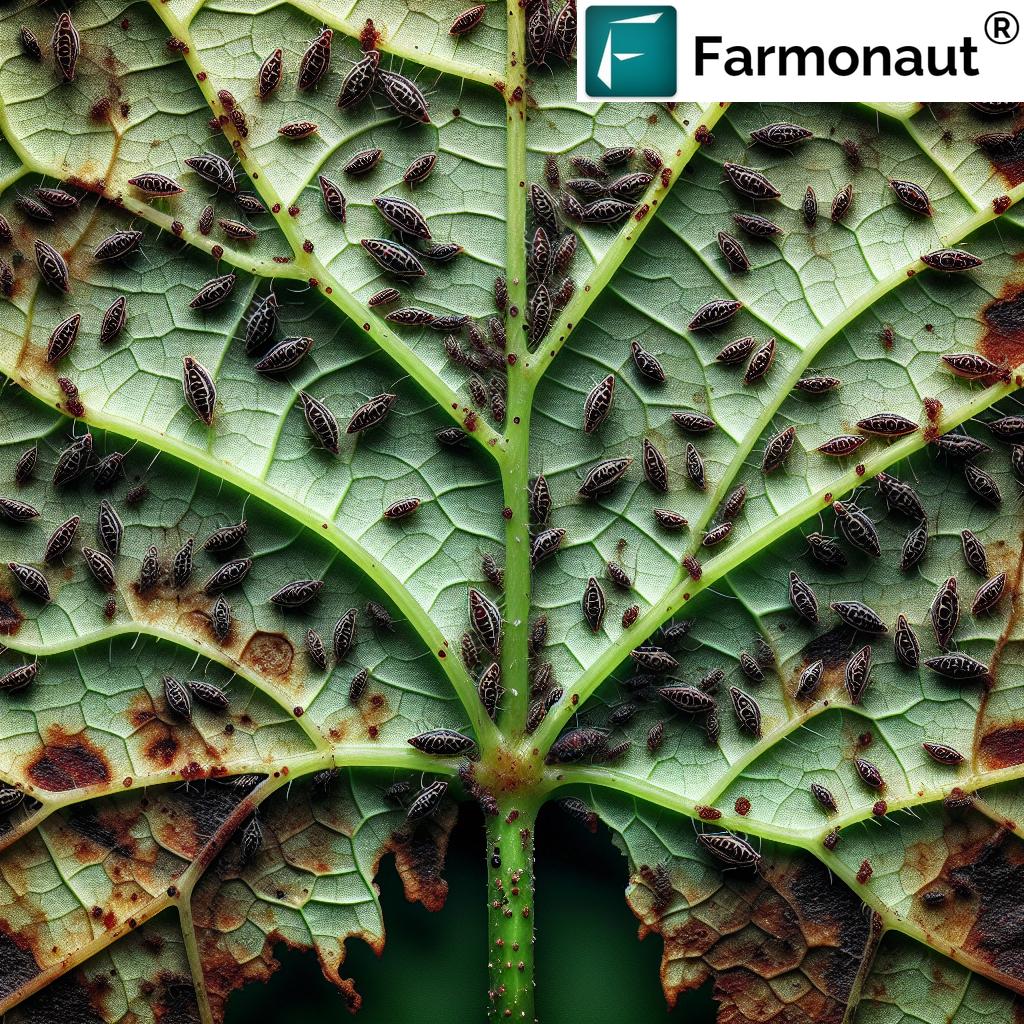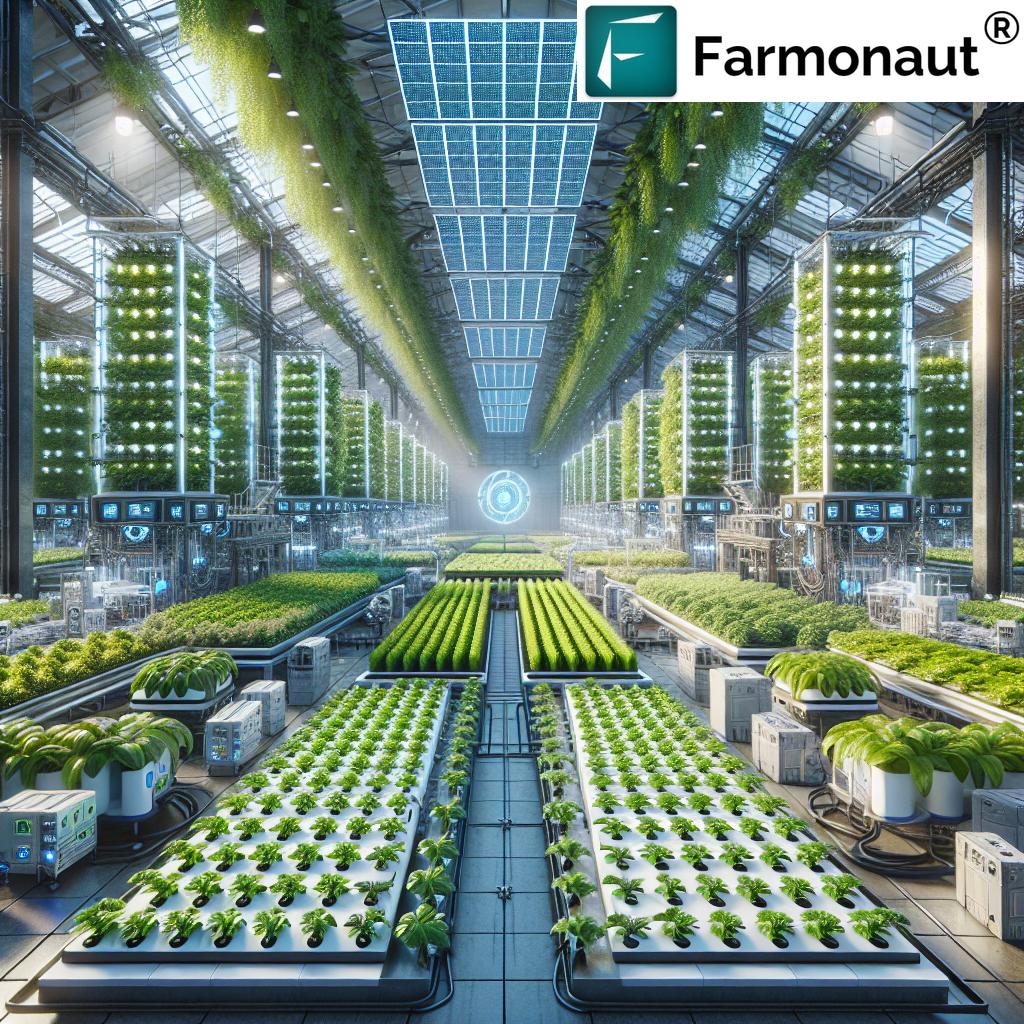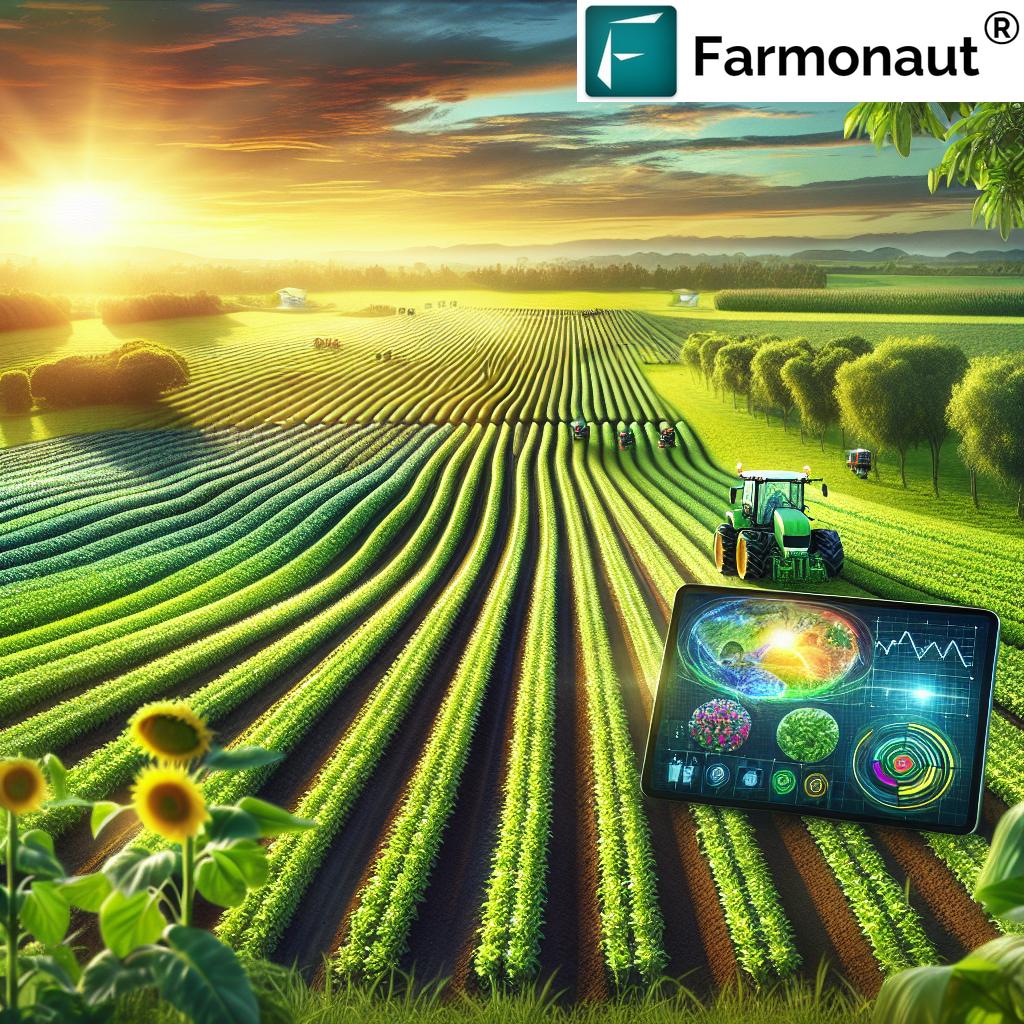AI Computer Vision Solution: Smart Agriculture Advantages
Table of Contents
- Introduction: AI Computer Vision Solution in Smart Agriculture
- Trivia
- The Evolution of Smart Agriculture with AI & Computer Vision
- Revolutionizing Farm Management with Advanced Software
- AI Computer Vision in Action: Precision & Productivity
- Comparative Impact: Traditional vs AI Computer Vision Smart Agriculture
- Empowering Sustainability & Environmental Responsibility
- Overcoming Labor Challenges with Automation & Robotics
- Digital Traceability, Transparency, and Market Opportunities
- Beyond Crops: AI Computer Vision for Forest Management
- Farmonaut: Ushering the Satellite-Driven AI Revolution
- The Future of Smart Agriculture: 2025 and Beyond
- Frequently Asked Questions
- Farmonaut Subscriptions
- Conclusion
Introduction: AI Computer Vision Solution in Smart Agriculture
Over the recent years, the integration of AI computer vision solution for smart agriculture has revolutionized the agriculture sector, paving the way for highly innovative and sustainable farming practices. As we approach 2025 and beyond, computer vision and artificial intelligence have become indispensable tools in modern farm management, helping farmers boost yields, reduce labor dependency, and manage resources with unparalleled efficiency.
At the core of transforming traditional farming into highly efficient and data-driven enterprises is the reality that computer vision and AI systems deploy advanced sensors, drones, and cameras to capture images and analyze farm data in real-time. This technological advancement enables farmers to monitor crops, assess soil health, predict environmental conditions, and respond with precision to the needs of each individual field.
Let’s explore how AI computer vision solution for smart agriculture and computer programs for farm management are enabling a new era of sustainable agriculture, optimized yields, and cost-effective farm operations.
The Evolution of Smart Agriculture with AI & Computer Vision
The advantages of smart agriculture are rooted in the powerful integration of AI computer vision solutions with advanced computer software for farm management. AI and machine learning algorithms are at the forefront, analyzing data from sensors, images, and videos collected by drones, tractors, and stationary platforms across fields.
- AI computer vision monitors crops for diseases, pest infestations, nutrient deficiencies, and water stress far earlier than is possible with the naked eye.
- This early detection is crucial for preventing extensive crop damage and reducing broad-spectrum pesticide usage, thus promoting sustainable farming practices.
- The precision and consistency delivered by computer vision dramatically improve farming quality compared to manual scouting and monitoring methods.
What Makes AI Computer Vision the Game Changer in Agricultural Sector?
Artificial intelligence has automated what used to be time-consuming, labor-intensive processes.
By deploying smart systems that analyze high-resolution images of crops, these solutions can:
- Spot fungal, bacterial, or viral diseases before symptoms fully appear.
- Identify pest outbreaks down to specific areas within a single field.
- Pinpoint water or nutrient stress that may affect yield.
- Provide real-time alerts and recommendations for targeted treatment or resource management.
The result? Farmers can make more informed decisions, optimize input application (fertilizers, pesticides, and water), and achieve cost savings while improving productivity and minimizing environmental impacts.
Revolutionizing Farm Management with Advanced Computer Programs
By 2025, computer programs for farm management have matured into sophisticated, all-in-one software platforms that integrate AI, machine learning, satellite technologies, and blockchain. These smart applications are accessible via web and mobile devices, offering intuitive dashboards and actionable insights for farmers and agri-enterprises worldwide.
- Data Integration: Inputs from satellite images, environmental sensors, crop monitors, and weather forecasts are fused and analyzed by AI-powered algorithms.
- Real-Time Analytics: Farmers can monitor crop growth, assess soil fertility, schedule irrigation, estimate harvest times, and manage labor requirements — all powered by intelligent decision support.
- Predictive Models: Machine learning enables advanced forecasting, letting farmers run ‘what-if’ scenarios based on climate variables, crop patterns, and market trends.
- Automation: Seamless pairing with autonomous tractors, robotic sprayers, and drones for precision field applications.
Farmonaut: AI, Satellite, and Blockchain Combined for Farm Success
At Farmonaut, we are committed to democratizing satellite-driven AI computer vision solutions for smart agriculture. Our API and easy-to-use mobile/web applications empower farmers, businesses, and governments to access real-time monitoring, blockchain-based traceability, and resource management tools.
A notable benefit, especially as sustainability becomes non-negotiable, is carbon footprint monitoring, helping users track and reduce emissions for greener farming operations.
AI Computer Vision in Action: Precision and Productivity
Let’s see how AI computer vision solution for smart agriculture translates advanced imagery into powerful, field-level decisions.
How Does AI Computer Vision Work in Crop Monitoring?
- Data Collection: High-resolution images and videos are captured by drones, satellites, or ground-based cameras.
- Image Analysis: Machine learning algorithms analyze image patterns to detect diseases, pest infestations, nutrient deficiencies, and water stress.
- Diagnosis: The system pinpoints exactly which areas within a field need intervention, whether it’s emergency irrigation, fungicides, or nutrient boost.
- Actionable Insights: Farm management software generates real-time recommendations, integrating with automated machinery for variable rate application.
Examples of AI-Driven Precision Agriculture
- Targeted Spraying: AI computer vision identifies weed patches and instructs robotic sprayers to apply herbicides only in necessary locations, drastically reducing chemical usage.
- Stress Mapping: Satellite and drone imagery reveals hotspots of water stress or nutrient deficiency.
- Automated Harvest Estimation: AI models estimate crop yield and readiness for harvest, assisting labor management and reducing losses.
The Output: Higher Productivity, Lower Input Costs, and Better Quality
- Increase yields by addressing issues earlier and optimizing every corner of a field.
- Reduce labor hours by automating scouting and application tasks.
- Minimize chemical use, enhancing the environmental health of the farm and surrounding ecosystems.
- Maximize quality by ensuring even, healthy crop growth.
Comparative Impact: Traditional vs AI Computer Vision Smart Agriculture
| Feature/Aspect | Traditional Agriculture (Estimated Values) |
AI Computer Vision Solution (Estimated Values) |
Improvement / Benefit |
|---|---|---|---|
| Crop Yield (kg/ha) | 6,000 | 7,500 | Up to 25% increase in yields |
| Labor Hours Required (per acre) |
40 | 28 | ~30% reduction in manual labor |
| Input Costs (USD/acre) | $180 | $120 | Significant cost savings |
| Water Usage (liters/ha) | 1,000,000 | 700,000 | ~30% less water needed |
| Pest Detection Accuracy (%) | 60% | 95% | Nearly perfect, early pest/disease detection |
| Sustainability Index (score 1-10) | 4 | 9 | Major gains in sustainable, eco-friendly practices |
This table illustrates just how transformative the integration of AI computer vision technologies and computer programs for farm management can be for modern agriculture, boosting not just yield and profitability, but also advancing sustainability and resource conservation.
Empowering Sustainability & Environmental Responsibility
The advantages of smart agriculture are profound when it comes to environmental sustainability. By deploying AI computer vision solutions, farmers can make more precise applications of pesticides, fertilizers, and water, leading to:
- Reduced chemical runoff into surrounding ecosystems.
- Preservation of soil health by avoiding excessive inputs.
- Protection of biodiversity, as chemical overuse is minimized and targeted.
- Lower carbon footprint and better compliance with environmental regulations thanks to platforms like Farmonaut’s Carbon Footprint Tracking for Agriculture.
Importantly, Farmonaut’s blockchain traceability solutions further boost transparency and build trust with consumers. Want to guarantee ethical product origins and gain access to new markets? See our Product Traceability Platform for robust, AI and blockchain-powered supply chain authentication.
Overcoming Labor Challenges with Automation & Robotics
Labor scarcity is one of the most pressing challenges in global agriculture. AI computer vision solutions directly address this issue by enabling widespread automation on modern farms:
- Autonomous tractors, robotic harvesters, and drones can perform repetitive, labor-intensive, and hazardous tasks with high accuracy and consistency.
- This automation reduces human exposure to chemicals and strenuous physical labor, enhancing safety on farms.
- Smart fleet management is made possible through AI and satellite connectivity — see our Fleet Management Solution for optimized machinery and logistics coordination.
Autonomous Decision Support: AI for People and Machines
- AI computer vision systems can detect plant diseases, pest infestations, and weed patches, then instruct sprayers or machinery to act only where necessary.
- Labor savings of up to 30% are possible — workforces become more efficient and can focus on higher-value tasks.
Digital Traceability, Transparency, and Market Opportunities
Digital traceability has rapidly become the backbone of compliance, market access, and consumer trust in agriculture. Leveraging blockchain and AI computer vision solutions:
- Producers and exporters can verify provenance, quality, and regulatory compliance for agricultural goods.
- Consumers and auditors have real-time access to data on soil health, crop management practices, and sustainability metrics from field to fork.
- Demand for farm-to-market traceability tools is growing, fueled by changing global trade standards and ESG requirements.
Farmonaut’s product traceability suite harnesses the power of satellite, AI, and blockchain, ensuring robust supply chain authentication and transparency for crops and other high-value resources.
Beyond Crops: AI Computer Vision for Forest Management
The applications of AI computer vision solutions extend past crops — they are transforming forest management and conservation:
- Monitoring forest health, detecting illegal activities (such as logging), and assessing wildfire risks.
- Satellite and drone imagery, analyzed by AI algorithms, provide detailed spatial data for managing resources sustainably.
- Environmental impact monitoring platforms, such as those offered through Farmonaut’s Crop Plantation & Forest Advisory System, provide end-to-end solutions for ecosystem health.
The integration of AI and computer vision is now essential not just for maximizing productivity in crops but also in preserving biodiversity, maintaining soil health, and safeguarding our future resources.
Farmonaut: Ushering the Satellite-Driven AI Revolution
As a leading satellite technology provider, we at Farmonaut are dedicated to making real-time satellite and AI-powered computer vision insights affordable and accessible for farmers, businesses, and governments worldwide.
- Satellite-based crop monitoring: Our multispectral imagery tracks crop stages, detects anomalies early, and delivers NDVI and soil condition metrics directly to farmers via Farmonaut’s App Platform.
- Jeevn AI Advisory System: Provides real-time recommendations, weather forecasts, and data-driven alerts for field actions, boosting operational efficiency.
- Blockchain-based traceability: Ensures integrity, security, and transparency for agricultural products from farm to market.
- Fleet and Resource Management: Our fleet management tool enables businesses to track and optimize usage of vehicles and field equipment.
- Environmental Impact Monitoring: Real-time tracking of carbon footprint and resource use to foster sustainable industry practices.
Farmonaut’s business model supports everyone—from smallholders in emerging economies to large-scale agri businesses and government agencies. Our technology stack features modular, API-driven integration, with industry-specific customization via our Large Scale Farm Management Platform.
The Future of Smart Agriculture: 2025 and Beyond
Looking ahead, continual improvements in AI algorithms, sensor accuracy, 5G connectivity, and edge computing will supercharge smart agriculture:
- Real-time, in-field AI decision-making will become more accessible, supporting fully autonomous farm operations.
- Precision technologies and computer vision will integrate with financial tools, enabling satellite-based verification for crop loans and insurance — reducing fraud and boosting access to credit.
- New advances in remote sensing, microclimate analysis, and environmental monitoring will allow smarter resource allocation and optimized sustainability scores.
- Farmonaut’s API and Developer Platform (Developer Docs) will support third-party innovation in the global smart agriculture ecosystem.
Frequently Asked Questions
What is an AI computer vision solution for smart agriculture?
It is a combination of advanced cameras, sensors, and AI algorithms that continuously monitor crops, soil, and environment to detect issues, optimize inputs, and automate tasks for precision farming.
How does computer vision reduce labor in agriculture?
By automating field scouting, pest/disease monitoring, and even targeted spraying or harvesting, AI computer vision systems reduce manual effort by up to 30%, freeing human labor for more value-added work.
Is smart agriculture sustainable?
Yes. Precision input application, early problem detection, environmental monitoring, and blockchain traceability all ensure that crops are grown with minimal waste and impact, supporting soil health and biodiversity.
What are the software options for farm management?
By 2025, farm management platforms like Farmonaut offer web, Android, and iOS solutions with satellite monitoring, AI advisory, and blockchain modules for real-time field insights.
Can these solutions work for small and large farms?
Absolutely. Systems are modular and scalable, serving individual farmers, enterprises, and government agencies — Farmonaut solutions are accessible for all.
How does Farmonaut ensure affordability?
We operate a subscription-based model, designed so farms of any size and region can access AI computer vision solutions without investing in costly new hardware.
How can developers or agri-businesses integrate Farmonaut tech?
Our API and developer documentation make it simple to embed satellite and AI insights into custom applications and workflows.
Farmonaut Subscription Plans: Affordable, Scalable, Powerful
Empower your agri-enterprise or government operation with real-time satellite and AI-based farm management insights using Farmonaut’s flexible subscription tiers. Accessible via web and mobile apps, our plans are designed for every scale—from smallholder farms to large industrial operations.
Conclusion
The integration of AI computer vision solutions and smart computer programs for farm management has forever changed the landscape of agriculture. By 2025, these systems are essential — supporting farmers in making highly informed decisions, increasing yields, and building sustainable, transparent, and efficient enterprises.
From real-time satellite-based monitoring to AI-powered crop health analysis, environmental impact tracking, and robust blockchain traceability, agriculture has entered a new era of data-driven productivity. The advantages of smart agriculture extend across farm sizes, geographies, and sectors — enhancing resource management and ensuring that opportunities of tomorrow are accessible today.
As we continue to innovate at Farmonaut, our mission remains clear: to make advanced AI and computer vision solutions available, affordable, and impactful for every stakeholder in the agriculture sector.
Discover the API Integration and developer documentation to embed AI, satellite, and blockchain power into your agri-business systems.











